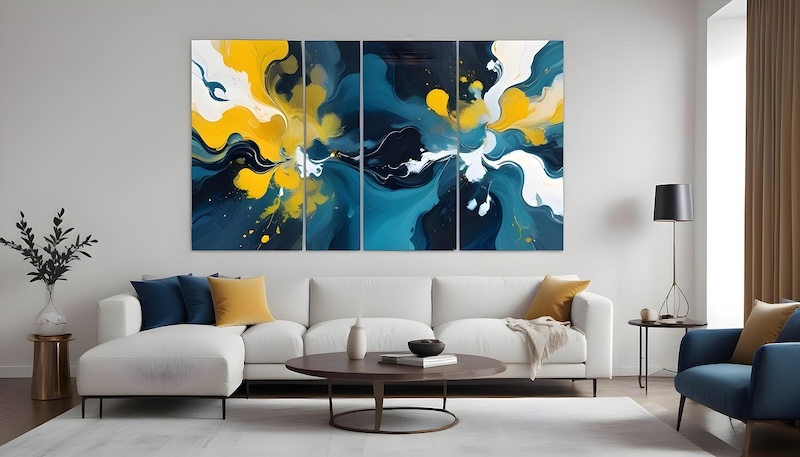5 Ways Texture Changes How a Room Feels – Walk into a room, and think. Is the first thing you really notice the colour of the walls and the shape of the furniture? Or is it something else you can’t quite put your finger on?
Often, it’s the feeling of the space, a subtle pull, a cosy embrace, and the touch of drama that we really feel. And that elusive quality is largely dictated by texture. It is what transforms interiors from flat and functional into layered, inviting, and unmistakably stylish.
Interior designers know that colour sets the stage, but texture tells the story. So, today, we’ve gathered to explore the top five ways texture reshapes our rooms and why incorporating it into our homes can elevate them from merely decorated to exquisitely designed.
- Texture Adds Depth and Dimension
One of texture’s most immediate effects is visual and spatial depth. Think of a room with sleek, smooth surfaces everywhere. It feels cold, flat, and lifeless, doesn’t it? But introduce a mix of textures, and suddenly the space becomes multidimensional, even if the colour palette remains neutral.
Experts often layer textiles, materials, and finishes to create an approachable but sophisticated look. A designer might place a velvet sofa against a raw timber wall, complement it with a nubby wool throw, and finish with a metallic side table. Each material catches the light differently, interacts with the others, and draws the eye, creating a sense of depth that is immediately pleasing.
Even small additions can work wonders: throw a woven basket, a fringed cushion, or a tactile rug, and your room will never feel one-note ever again. Texture is that magical detail that invites the eye to linger.
- Texture Shapes Mood
But it’s not just eye candy. Texture also knows how to speak to the senses. The soft nap of a velvet cushion, the rough grain of reclaimed wood, or the smooth coolness of a marble surface can subtly dictate how a room feels.
Interior designers often describe texture as the emotional layer of design. Soft, plush textures evoke warmth, intimacy, and comfort. They’re the materials that make you want to curl up with a book or sink into conversation. Rougher, more organic textures, on the other hand, feel grounded, earthy, and tactilely interesting, offering a quiet sophistication that can make a room feel surprisingly alive.
So, be bold and pair unexpected textures, such as a silky throw draped over a boucle armchair, to create a sense of playful tension. Texture is basically mood made tangible.
- Texture Controls Perception of Space
Texture can also subtly manipulate how we perceive space. Yes, you read us right. Smooth, reflective surfaces, such as glass, lacquered wood, or high-gloss tiles, can make a room feel larger, more open, and airy. Conversely, tactile, matte, or layered surfaces absorb light and can make even the most cavernous spaces feel cosy and intimate.
Designers use this knowledge to craft experiences. In a minimalist loft, a thick, shaggy rug instantly breaks up the expanse of polished concrete, creating a welcoming zone for conversation. In a sprawling country home, layered linen curtains, raw timber accents, and handwoven rugs can prevent vast rooms from feeling cold or impersonal.
How texture interacts with scale and light is what makes the difference between a room that looks styled in a catalogue and one that feels actually well-lived-in and loved.
- Texture Creates a Sense of Movement
While it may seem so at first glance, texture isn’t static. Because it guides the eye, it naturally creates rhythm in a room. Repeated or varied textures can lead the viewer from one corner to another.
Interior experts often play with textures to orchestrate this visual choreography. A tactile rug can draw attention to a seating area, a sculpted throw can subtly highlight a sofa, and a patterned wood panel can lead the eye upward toward an architectural feature. Even the simplest spaces benefit from this invisible motion; it gives a sense of narrative and flow, making the room feel intentional rather than accidental.
Movement through texture also helps balance eclectic spaces. Layering different materials, such as linen, velvet, stone, and metal, will create visual intrigue and keep rooms engaging without feeling cluttered. It’s about crafting energy, directing it gracefully, and letting each surface contribute its voice to the overall harmony.
- Textured Wall Art Elevates the Room
If you’ve ever run your fingers across a raised canvas or admired a mixed-media installation, you’ve experienced the power of textured wall art. Far from being mere decoration, these pieces add dimension and personality, often becoming the focal point around which the rest of the room is styled.
Designers increasingly consider wall art not just visually, but tactually. Relief sculptures, 3D canvases, and layered textiles on walls introduce shadow and depth, making rooms feel alive. A neutral bedroom, for instance, can go from serene to striking with a single sculptural canvas, while a textured abstract in a living area can unify otherwise disparate elements.
Textured wall art bridges the gap between décor and design, reminding us that even the vertical plane of a room can be dynamic, interactive, and full of character.
The Invisible Hand of Texture
Texture absolutely has the power to shape our experience, and it can turn any room from functional to enchanting, warm, dramatic, playful, or serene. Anything you need it to be, really.
The secret, according to designers, is not to fear mixing textures. The juxtaposition of rough and smooth, soft and structured, muted and bold creates harmony that feels lived-in and yet curated.
So, next time you decorate a room, think beyond colour and shape. Run your fingers over fabrics, lean against walls, explore art in relief, and consider how each material affects your senses. Because in interiors, texture is actually emotion made tangible.
Poppy Watt


